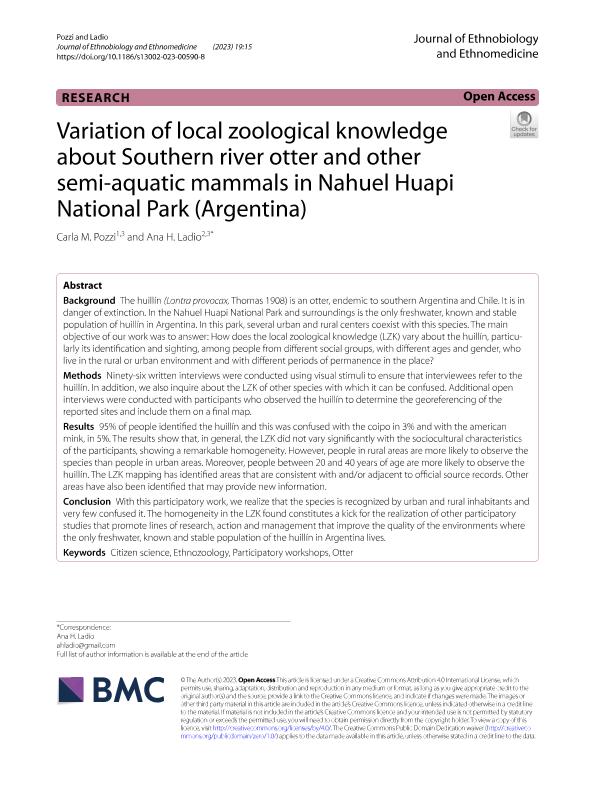Mostrar el registro sencillo del ítem
dc.contributor.author
Pozzi, Carla Martina

dc.contributor.author
Ladio, Ana Haydee

dc.date.available
2024-04-08T10:13:05Z
dc.date.issued
2023-05
dc.identifier.citation
Pozzi, Carla Martina; Ladio, Ana Haydee; Variation of local zoological knowledge about Southern river otter and other semi-aquatic mammals in Nahuel Huapi National Park (Argentina); BioMed Central; Journal of Ethnobiology and Ethnomedicine; 19; 1; 5-2023; 1-12
dc.identifier.issn
1746-4269
dc.identifier.uri
http://hdl.handle.net/11336/232227
dc.description.abstract
Background: The huillín (Lontra provocax, Thomas 1908) is an otter, endemic to southern Argentina and Chile. It is in danger of extinction. In the Nahuel Huapi National Park and surroundings is the only freshwater, known and stable population of huillín in Argentina. In this park, several urban and rural centers coexist with this species. The main objective of our work was to answer: How does the local zoological knowledge (LZK) vary about the huillín, particularly its identifcation and sighting, among people from diferent social groups, with diferent ages and gender, who live in the rural or urban environment and with diferent periods of permanence in the place? Methods: Ninety-six written interviews were conducted using visual stimuli to ensure that interviewees refer to the huillín. In addition, we also inquire about the LZK of other species with which it can be confused. Additional open interviews were conducted with participants who observed the huillín to determine the georeferencing of the reported sites and include them on a fnal map. Results 95% of people identifed the huillín and this was confused with the coipo in 3% and with the american mink, in 5%. The results show that, in general, the LZK did not vary signifcantly with the sociocultural characteristics of the participants, showing a remarkable homogeneity. However, people in rural areas are more likely to observe the species than people in urban areas. Moreover, people between 20 and 40 years of age are more likely to observe the huillín. The LZK mapping has identifed areas that are consistent with and/or adjacent to ofcial source records. Other areas have also been identifed that may provide new information. Conclusion: With this participatory work, we realize that the species is recognized by urban and rural inhabitants and very few confused it. The homogeneity in the LZK found constitutes a kick for the realization of other participatory studies that promote lines of research, action and management that improve the quality of the environments where the only freshwater, known and stable population of the huillín in Argentina lives.
dc.format
application/pdf
dc.language.iso
eng
dc.publisher
BioMed Central

dc.rights
info:eu-repo/semantics/openAccess
dc.rights.uri
https://creativecommons.org/licenses/by/2.5/ar/
dc.subject
citizen science
dc.subject
ethnozoology
dc.subject
participatory workshop
dc.subject
otter
dc.subject.classification
Conservación de la Biodiversidad

dc.subject.classification
Ciencias Biológicas

dc.subject.classification
CIENCIAS NATURALES Y EXACTAS

dc.title
Variation of local zoological knowledge about Southern river otter and other semi-aquatic mammals in Nahuel Huapi National Park (Argentina)
dc.type
info:eu-repo/semantics/article
dc.type
info:ar-repo/semantics/artículo
dc.type
info:eu-repo/semantics/publishedVersion
dc.date.updated
2024-04-05T12:31:46Z
dc.journal.volume
19
dc.journal.number
1
dc.journal.pagination
1-12
dc.journal.pais
Países Bajos

dc.description.fil
Fil: Pozzi, Carla Martina. Administración de Parques Nacionales. Delegación Regional Patagonia; Argentina
dc.description.fil
Fil: Ladio, Ana Haydee. Consejo Nacional de Investigaciones Científicas y Técnicas. Centro Científico Tecnológico Conicet - Patagonia Norte. Instituto de Investigaciones en Biodiversidad y Medioambiente. Universidad Nacional del Comahue. Centro Regional Universidad Bariloche. Instituto de Investigaciones en Biodiversidad y Medioambiente; Argentina
dc.journal.title
Journal of Ethnobiology and Ethnomedicine
dc.relation.alternativeid
info:eu-repo/semantics/altIdentifier/url/https://ethnobiomed.biomedcentral.com/articles/10.1186/s13002-023-00590-8
dc.relation.alternativeid
info:eu-repo/semantics/altIdentifier/doi/http://dx.doi.org/10.1186/s13002-023-00590-8
Archivos asociados
